Experimental Study on Wetland Hydraulic Characteristics of Vegetated Drainage Ditches
Abstract
:1. Introduction
2. Materials and Methods
2.1. Study Site
2.2. Experiment Design and Measurements
2.2.1. Experiment Design
2.2.2. Measurements
Section Measurement: Cross- and Longitudinal-Section Measurement
Measurement of Flow and Velocity of the Ditch
Measurement of Plant Density and Plant Morphological Parameters
2.3. Data Analysis
3. Results
3.1. Variation of the Roughness Coefficient of Drainage Ditch with Vegetation
3.2. Variation of Plant Resistance to Water Flow
3.3. Relationship between Plant Drag Coefficient and Stem Reynolds Number
3.4. Wetland Hydraulic Characteristics of a Drainage Ditch with Vegetation
4. Discussion
5. Conclusions
- (1)
- The roughness coefficient of the drainage ditch with vegetation declines as the water flow rate increases, with its value lying between that of the small natural river and that of the free surface flow-constructed wetland. When it comes to different plants, , the drainage ditch with vegetation is capable of floodwater discharge when the flow rate is large.
- (2)
- Plant resistance to water flow increases as the flow rate rises; for different plants the flow rate remains the same, , which is because the total stem area of Juncus in the upstream direction is the largest.
- (3)
- The plant drag coefficient Cd declines as the flow rate increases; the eigenvalue k of correlation coefficient of plant drag coefficient Cd’ without the impact of plant density and Reynolds number Res varies in different plants. When it comes to Juncus, Zizania latifolia, and Acorus calamus, this value k is 1.79, 1.65, and 1.49, respectively.
- (4)
- As the water flow rate rises, the residence time of the drainage ditch with vegetation, as a kind of band wetland, declines while the hydraulic surface loading becomes larger. Drainage ditches with vegetation show excellent wetland hydraulic performance when the flow rate is small.
Acknowledgments
Author Contributions
Conflicts of Interest
References
- Needelman, B.A.; Kleinman, P.J.A.; Strock, J.S.; Allen, A.L. Improved management of agricultural drainage ditches for water quality protection: An overview. J. Soil Water Conserv. 2007, 62, 171–178. [Google Scholar]
- Ree, W.O.; Palmer, V.J. Flow of Water in Channels Protected by Vegetative Linings; USA Department of Agriculture: Washington, DC, USA, 1949.
- Kouwen, N.; Unny, T.; Hill, H.M. Flow retardance in vegetated channels. J. Irrig. Drain. Div. 1969, 95, 329–344. [Google Scholar]
- Kouwen, N. Modern approach to design of grassed channels. J. Irrig. Drain. Eng. 1992, 118, 733–743. [Google Scholar] [CrossRef]
- Kouwen, N.; Fathi-Moghadam, M. Friction factors for coniferous trees along rivers. J. Hydraul. Eng. 2000, 126, 732–740. [Google Scholar] [CrossRef]
- Wu, F.-C.; Shen, H.W.; Chou, Y.-J. Variation of roughness coefficients for unsubmerged and submerged vegetation. J. Hydraul. Eng. 1999, 125, 934–942. [Google Scholar] [CrossRef]
- Huai, W.-X.; Han, J.; Zeng, Y.-H.; An, X.; Qian, Z.-D. Velocity distribution of flow with submerged flexible vegetations based on mixing-length approach. Appl. Math. Mech. 2009, 30, 343–351. [Google Scholar] [CrossRef]
- Hu, Y.; Huai, W.; Han, J. Analytical solution for vertical profile of streamwise velocity in open-channel flow with submerged vegetation. Environ. Fluid Mech. 2013, 13, 389–402. [Google Scholar] [CrossRef]
- Lightbody, A.; Nepf, H. Prediction of near-field shear dispersion in an emergent canopy with heterogeneous morphology. Environ. Fluid Mech. 2006, 6, 477–488. [Google Scholar] [CrossRef]
- Luhar, M.; Nepf, H.M. Flow-induced reconfiguration of buoyant and flexible aquatic vegetation. Limnol. Oceanogr. 2011, 56, 2003–2017. [Google Scholar] [CrossRef]
- Nepf, H.M. Hydrodynamics of vegetated channels. J. Hydraul. Res. 2012, 50, 262–279. [Google Scholar] [CrossRef]
- Tiner, R.W. Wetland definitions and classifications in the united states. In National Water Summary on Wetland Resources; Fretwell, J.D., Williams, J.S., Redman, P.J., Eds.; USA Geological Survey: Reston, VA, USA, 1996; Volume 2425, pp. 27–34. [Google Scholar]
- Liu, W.-L.; Deng, W.; Wang, G.-X.; Li, A.-M.; Zou, J. Aquatic macrophyte status and variation characteristics in the past 50 years in hongzehu lake. J. Hydroecol. 2009, 6, 1079–1083. [Google Scholar]
- Armitage, P.D.; Szoszkiewicz, K.; Blackburn, J.H.; Nesbitt, I. Ditch communities: A major contributor to floodplain biodiversity. Aquat. Conserv. Mar. Freshw. Ecosyst. 2003, 13, 165–185. [Google Scholar] [CrossRef]
- Mazerolle, M.J. Drainage ditches facilitate frog movements in a hostile landscape. Landsc. Ecol. 2005, 20, 579–590. [Google Scholar] [CrossRef]
- Wu, P.; Chen, Y.; Zhao, Y.; Hu, Y.; Huang, L.; Zhang, Z. Plant species diversity in agricultural drainage ditches in lingwu district of ningxia, northwest china. Chin. J. Ecol. 2011, 30, 2790–2796. [Google Scholar]
- Cheng, Z.; He, T.-H.; Guo, L.-H.; Zhang, Y.-F. Preliminary research of the structure of higher plant community in the wet land of ditches and canals on yinchuan plain. J. Agric. Sci. 2010, 31, 40–43. [Google Scholar]
- Kröger, R.; Holland, M.; Moore, M.; Cooper, C. Hydrological variability and agricultural drainage ditch inorganic nitrogen reduction capacity. J. Environ. Qual. 2007, 36, 1646–1652. [Google Scholar] [CrossRef] [PubMed]
- He, J.; Cui, Y.; Lv, L.; Yi, F.; Duan, Z. Experiments on removal effects of ditch-pond wetland system on n and p pollutants from paddy field. J. Agro-Environ. Sci. 2011, 30, 1872–1879. [Google Scholar]
- Peng, S.-Z.; Gao, H.-Z.; Zhang, Z.-L. Effect of pond wetland on n and p removal in drainage water from paddy field and its mechanism. J. Hydraul. Eng. 2010, 41, 406–411. [Google Scholar]
- Jiang, C.; Fan, X.; Cui, G.; Zhang, Y. Removal of agricultural non-point source pollutants by ditch wetlands: Implications for lake eutrophication control. Hydrobiologia 2007, 581, 319–327. [Google Scholar] [CrossRef]
- Alexander, R.B.; Smith, R.A.; Schwarz, G.E. Effect of stream channel size on the delivery of nitrogen to the gulf of mexico. Nature 2000, 403, 758–761. [Google Scholar] [CrossRef] [PubMed]
- Applegate, C.S.; Wilder, B.; DeShaw, J.R. Total nitrogen removal in a multi-channel oxidation system. Water Pollut. Control Fed. 1980, 52, 568–577. [Google Scholar]
- Stern, D.A.; Khanbilvardi, R.; Alair, J.C.; Richardson, W. Description of flow through a natural wetland using dye tracer tests. Ecol. Eng. 2001, 18, 173–184. [Google Scholar] [CrossRef]
- Sutherland, W.J. The Conservation Handbook: Research, Management and Policy; John Wiley & Sons: Hoboken, NJ, USA, 2008. [Google Scholar]
- Arcement, G.J., Jr.; Schneider, V.R. Guide for Selecting Manning’s Roughness Coefficients for Natural Channels and Flood Plains; USA Government Printing Office: Washington, DC, USA, 1989.
- Petryk, S.; Bosmajian, G., III. Analysis of flow through vegetation. J. Hydraul. Division 1975, 101, 871–884. [Google Scholar]
- Kadlec, R.H. Detention and mixing in free water wetland. Ecol. Eng. 1994, 3, 345–380. [Google Scholar] [CrossRef]
- Technical Specification of Constructed Wetlands for Wastewater Treatment Engineering; Ministry of Environment Protection the People’s Republic of China: Beijing, China, 2010.
- Rhee, D.S.; Woo, H.; Kwon, B.; Ahn, H.K. Hydraulic resistance of some selected vegetation in open channel flows. River Res. Appl. 2008, 24, 673–687. [Google Scholar] [CrossRef]
- Abood, M.M.; Yusuf, B.; Mohammed, T.A.; Ghazali, A.H. Manning roughness coefficient for grass-lined channel. J. Sci. Technol. 2006, 13, 317–330. [Google Scholar]
- Nikora, V.; Larned, S.; Nikora, N.; Debnath, K.; Cooper, G.; Reid, M. Hydraulic resistance due to aquatic vegetation in small streams: Field study. J. Hydraul. Eng. 2008, 134, 1326–1332. [Google Scholar] [CrossRef]
- Sukhodolov, A.N.; Sukhodolova, T.A. Case study: Effect of submerged aquatic plants on turbulence structure in a lowland river. J. Hydraul. Eng. 2009, 136, 434–446. [Google Scholar] [CrossRef]
- Kadlec, R.H.; Wallace, S. Treatment Wetlands, 2nd ed.; CRC press: Boca Raton, FL, USA, 2008; pp. 37–40. [Google Scholar]
- Mazda, Y.; Wolanski, E.; King, B.; Sase, A.; Ohtsuka, D.; Magi, M. Drag force due to vegetation in mangrove swamps. Mangroves Salt Marshes 1997, 1, 193–199. [Google Scholar] [CrossRef]
- Mei, R. An approximate expression for the shear lift force on a spherical particle at finite reynolds number. Int. J. Multiph. Flow 1992, 18, 145–147. [Google Scholar] [CrossRef]
- Abraham, F.F. Functional dependence of drag coefficient of a sphere on reynolds number. Phys. Fluids 1970, 13, 2194–2195. [Google Scholar] [CrossRef]
- Lee, J.K.; Roig, L.C.; Jenter, H.L.; Visser, H.M. Drag coefficients for modeling flow through emergent vegetation in the florida everglades. Ecol. Eng. 2004, 22, 237–248. [Google Scholar] [CrossRef]
- Wilson, C. Flow resistance models for flexible submerged vegetation. J. Hydrol. 2007, 342, 213–222. [Google Scholar] [CrossRef]

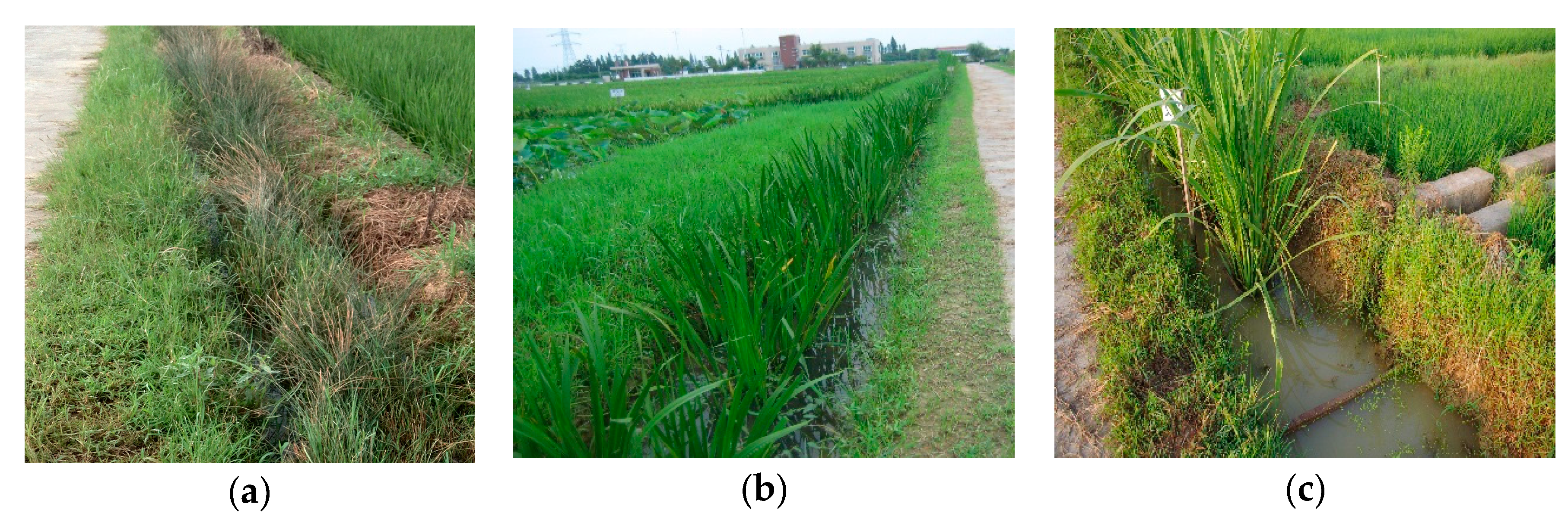

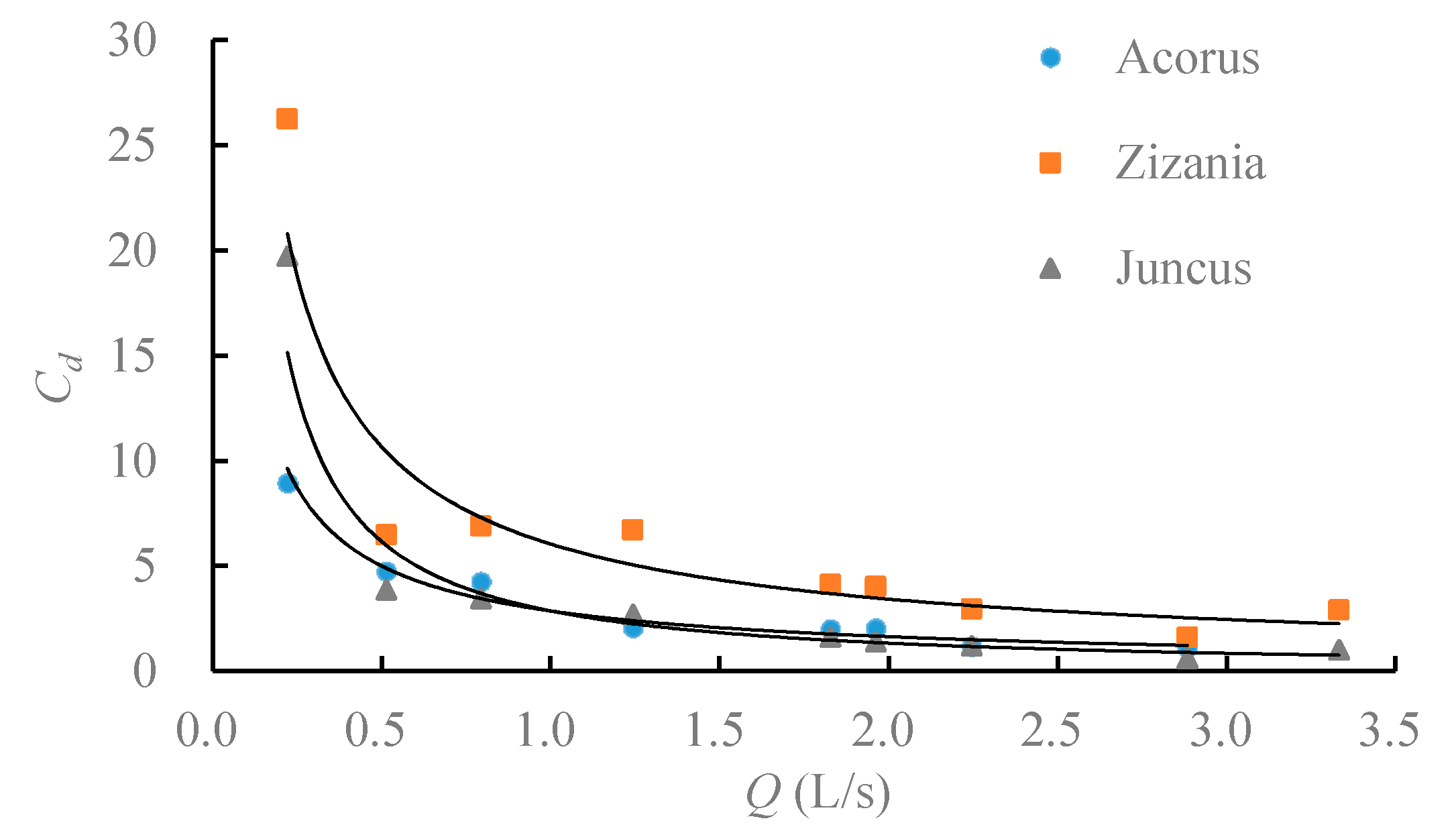
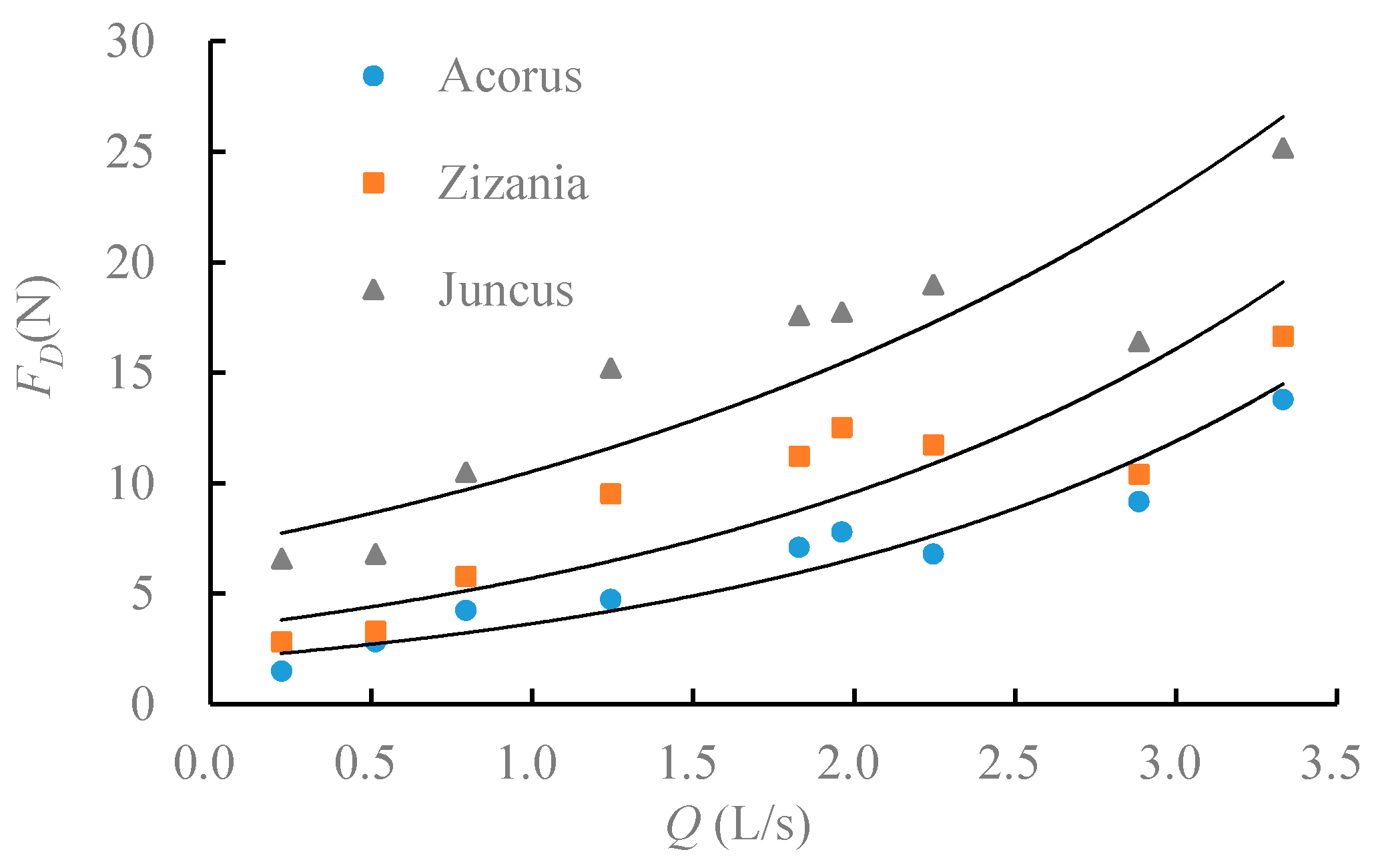
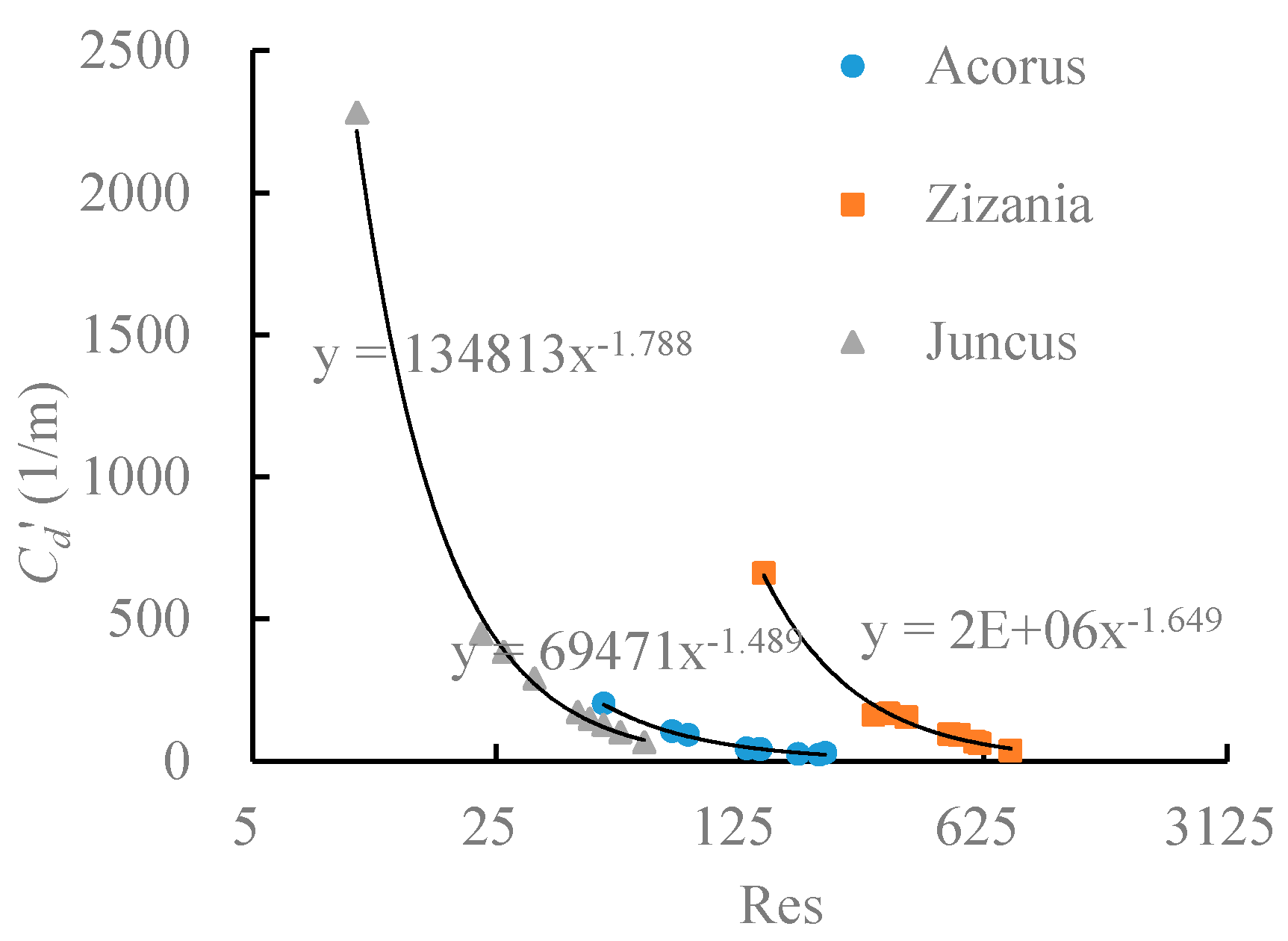
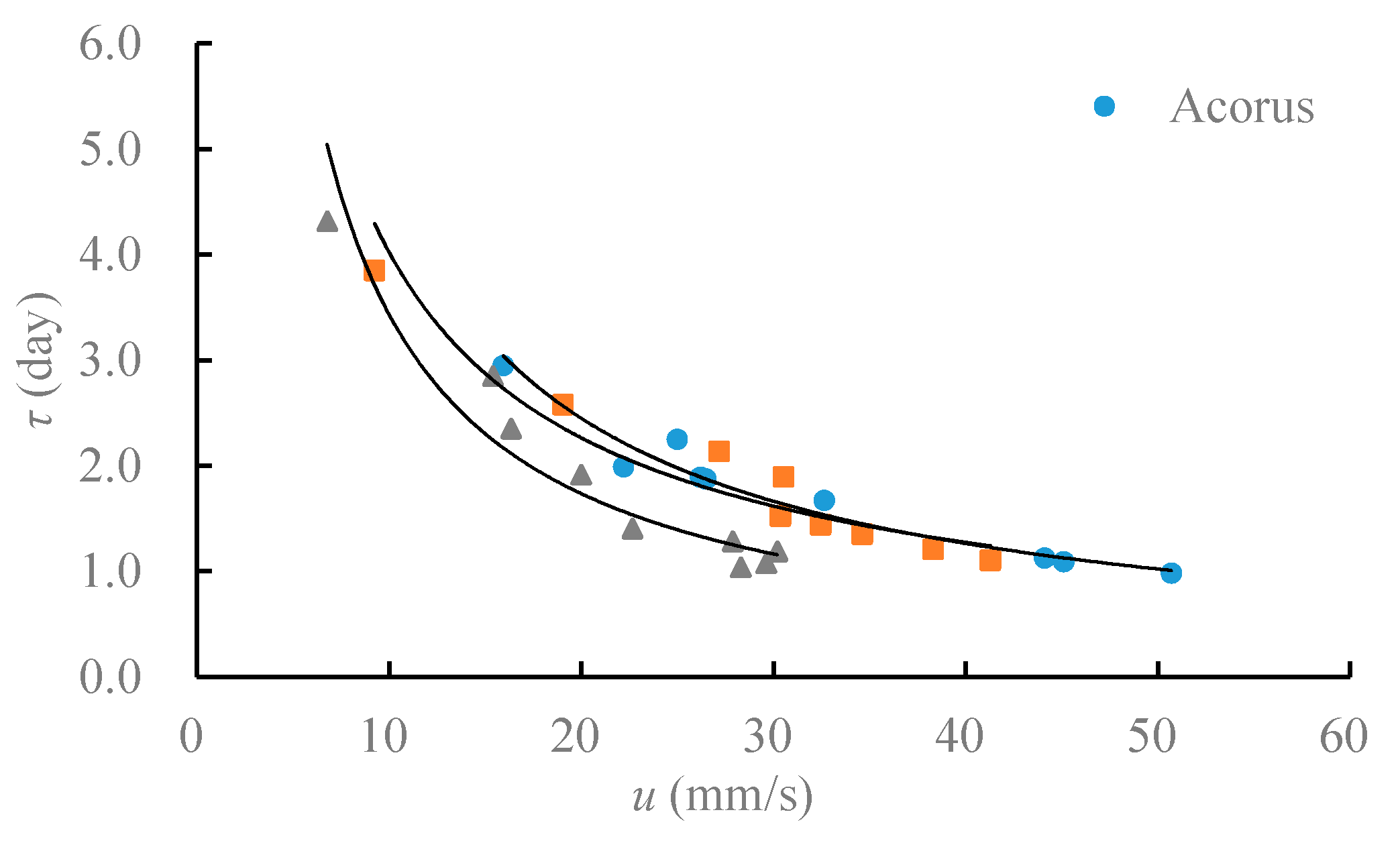
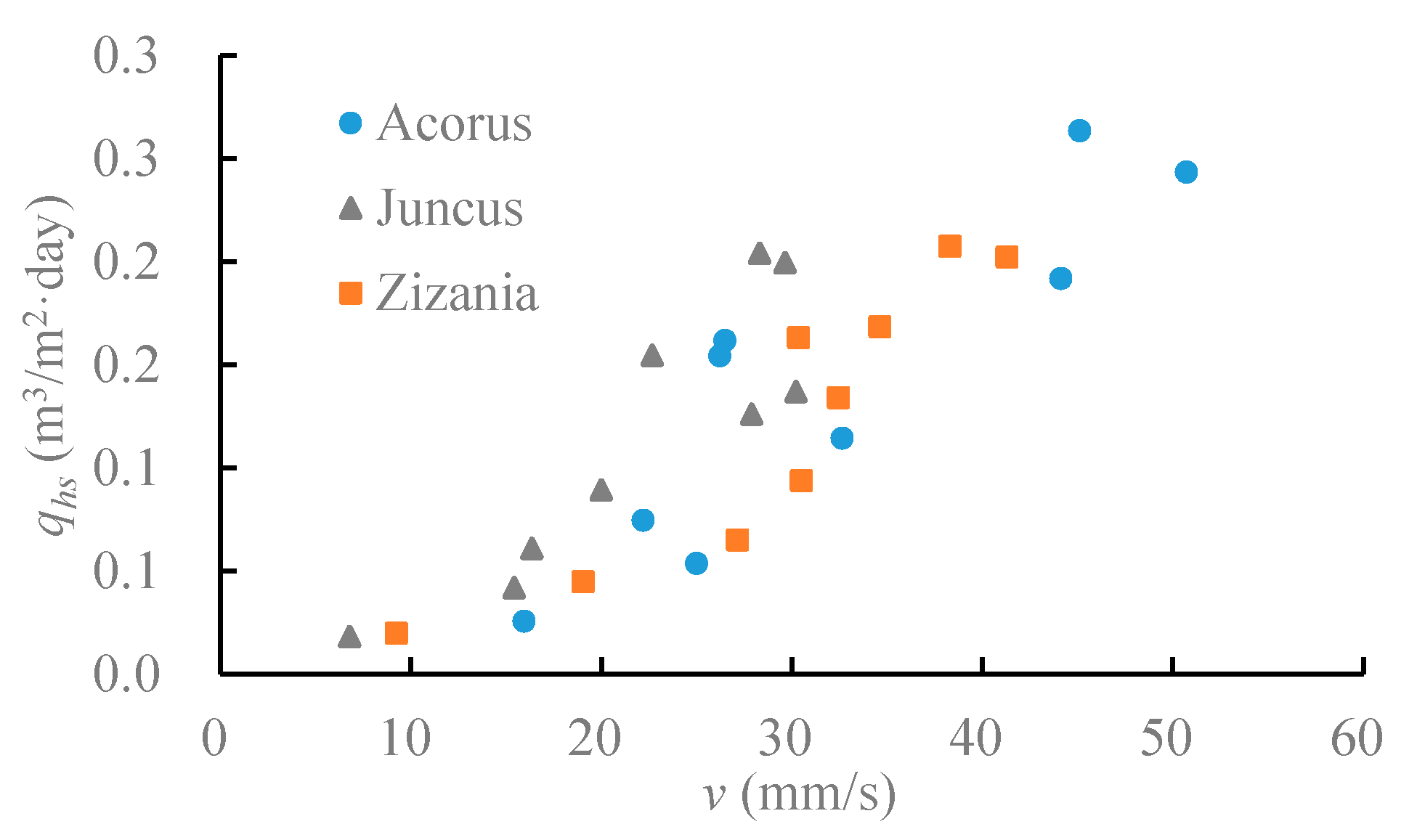
© 2017 by the authors. Licensee MDPI, Basel, Switzerland. This article is an open access article distributed under the terms and conditions of the Creative Commons Attribution (CC BY) license (http://creativecommons.org/licenses/by/4.0/).
Share and Cite
Zhao, S.; Cui, Y.; Luo, Y.; Li, P. Experimental Study on Wetland Hydraulic Characteristics of Vegetated Drainage Ditches. Water 2017, 9, 311. https://doi.org/10.3390/w9050311
Zhao S, Cui Y, Luo Y, Li P. Experimental Study on Wetland Hydraulic Characteristics of Vegetated Drainage Ditches. Water. 2017; 9(5):311. https://doi.org/10.3390/w9050311
Chicago/Turabian StyleZhao, Shujun, Yuanlai Cui, Yufeng Luo, and Peifeng Li. 2017. "Experimental Study on Wetland Hydraulic Characteristics of Vegetated Drainage Ditches" Water 9, no. 5: 311. https://doi.org/10.3390/w9050311




